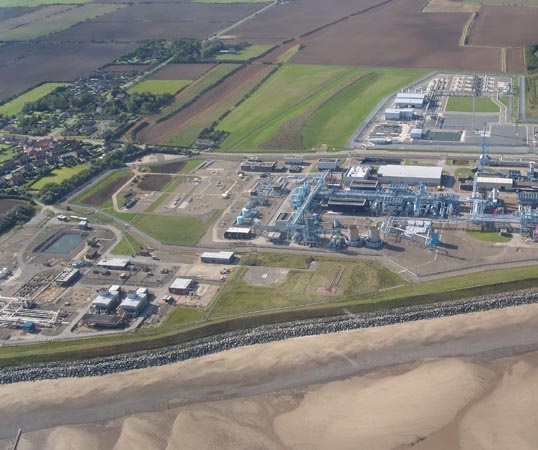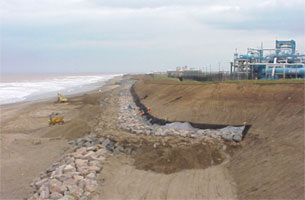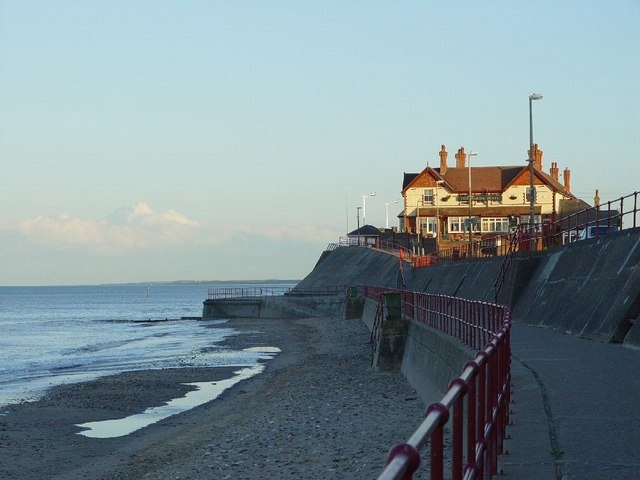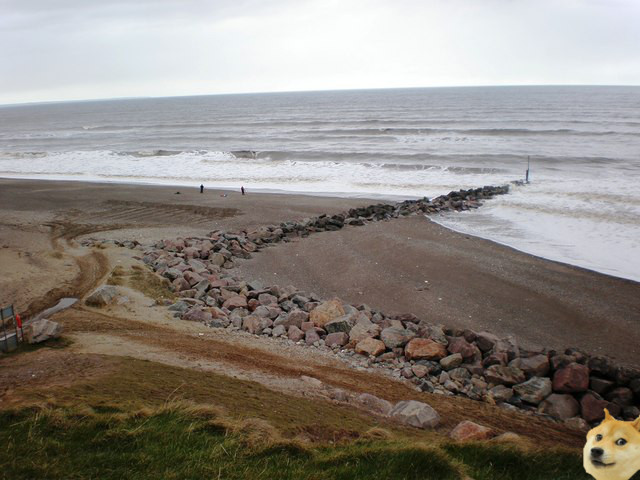I'm Mr. Baggins and I'm an employee at the BP owned Easington Gas Terminal. This gas terminal is located very close to the spit on the Holderness coast, and it's situated very close to the coastline which suffers from severe erosion.

Easington Gas Terminal & Defences.
Easington Gas Terminal is very important to the local economy as it provides a large source of jobs and also energy from the gas. Because of all this it is considered valuable land and a lot of money has been invested into protecting this gas terminal from erosion.
The main form of protection that has been constructed are rock revetments. These are large granite boulders which create a wall and a line of defence on the shoreline. It absorbs the wave energy because of the large air spaces between the boulders and the broad surface area.
These revetments were extremely expensive however they provide long lasting protection and will also secure the jobs of everyone who works here.

Rock Revetments that Line the Coast.
My name is Ms. Ermagherd and I am the manager of a hotel in Hornsea on the Holderness coastline. My hotel is directly on the edge of the coastline therefore erosion has been a big threat to my business. My beach-side hotel is a very attractive location to tourists due to the nice views and beaches.

The Sea Wall and my Hotel on the Coast.
Hornsea is home to sandy beaches and short cliffs that are prone to quick erosion. The sea has been a big problem for the people of Hornsea and long shore drift especially has resulted in the beaches shrinking rapidly.
To counter this longshore drift the council constructed wooden groynes along the coastline which have severely reduced the rate of erosion and saved much of the village.

Some Wooden Groynes in Hornsea.
Because erosion is so severe large sea walls were also built on the most valuable land such as that by my hotel. These sea walls will last for a very long time and pretty much stop the erosion completely, but not protect the beaches.
Because the beaches are not fully protected the council has been doing some soft engineering and nourishing the beach at Hornsea. They have been pumping offshore sand straight onto the beach which has been creating a wider beach to protect the cliff line and to add more sediment into the coastal system so that areas further south benefit (downdrift).
Sadly beach nourishment is not a permanent solution and those areas that aren't protected with groynes have to be regularly nourished every one or two years.
The implementation of the hard engineering defences such as groynes and the sea wall especially has slightly ruined the aesthetic appeal of the local area, possibly affecting my business. Tourists are always moaning about how terrible the sea wall looks, which can be a pain.
My name is Mr. Doge and for 35 years I've been the owner of a fish and chip shop in Mappleton, Yorkshire. When I first set up my business here the Mappleton coastline was composed of large beaches and steep cliffs which attracted many tourists back in the day, making my business boom.
Things turned sour in the early 90's when a new set of groynes were constructed in the town of Hornsea, just to the north. These new groynes worked wonders in Hornsea however starved our beaches of sediment as they halted the natural process of long shore drift, allowing the sea to erode nearly 4 metres of cliff a year putting our entire village in danger (this process is known as terminal groyne syndrome).
The people of Mappleton launched a campaign to the council to protect our coastline and thankfully the Humberside council responded by investing £2 million into constructing rock groynes made out of large boulders. The cliff face was also rebuilt to make it less steep and therefore more stable.
Sadly a small percentage of tourists are put off by the groynes as they believe they are ugly, and therefore my business isn't as successful as it used to be.

Rock Groynes on the Beach at Mappleton.





 RSS Feed
RSS Feed